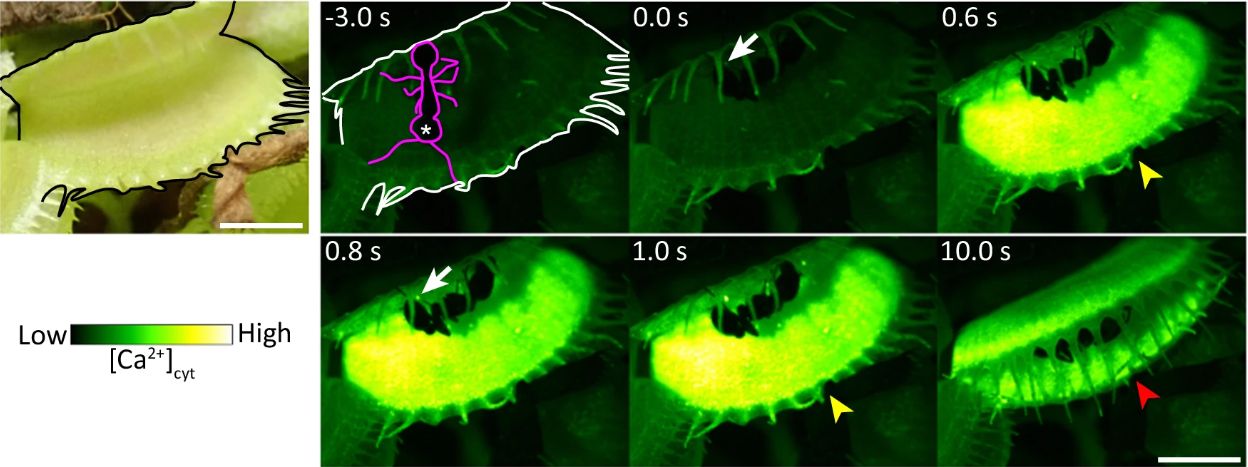Science
New Study Reveals Mechanosensor Behind Venus Flytrap Reactions

Research has uncovered a key mechanosensor that enables the rapid response of the Venus flytrap (Dionaea muscipula) to prey. The study, led by Hiraku Suda and colleagues, was published in Nature Communications and sheds light on the complex mechanisms that allow these carnivorous plants to react with astonishing speed.
The Venus flytrap relies on specialized sensory hairs located on its leaves to detect movement. When these hairs are triggered, they initiate a series of calcium signals that lead to the trap snapping shut on unsuspecting insects. While previous studies indicated that calcium threshold signals play a crucial role, the precise mechanism remained unclear until now.
Mechanosensor Discovery
The researchers identified a stretch-activated chloride ion channel known as DmMSL10 as central to this process. By creating a variant of the flytrap that lacked this specific mechanosensor, they were able to compare its response to the wild-type plant. Both variants demonstrated calcium ion release when the sensory hairs were activated, yet the knockout variant showed a significantly reduced rate of action potential generation.
In practical terms, this means that while the wild-type Venus flytrap continued to generate action potentials even after stimulation ceased, the knockout variant did not. This discovery illustrates the importance of DmMSL10 in detecting even the slightest touch and ensuring efficient prey capture.
Experimental Validation
To further validate their findings, the researchers conducted experiments where ants were allowed to wander on the leaves of both the wild and knockout variants. The results were striking. The wild-type plant successfully captured the first ant that came into contact with its leaves, while the knockout type remained unresponsive, failing to close despite four ants walking across its surface. This lack of response underscores the critical role of the DmMSL10 mechanosensor in prey detection.
The implications of this research extend beyond understanding the Venus flytrap. The findings provide insights into how similar mechanisms may have evolved in other species, including animals. As researchers continue to explore these connections, they may uncover further details about the evolutionary adaptations that enable such remarkable responsiveness to environmental stimuli.
In conclusion, the identification of the DmMSL10 mechanosensor advances our understanding of how the Venus flytrap and related species operate. This research not only highlights the intricate biology of these plants but also opens avenues for future studies into plant and animal sensory systems.
-

 Politics5 days ago
Politics5 days agoLB Pharmaceuticals Quiet Period Ends October 21, Analysts Weigh In
-

 World5 days ago
World5 days agoExposing the Reality Behind Guatemala’s Garment Industry
-

 Business5 days ago
Business5 days agoRoyal Bank of Canada Upgrades Ovintiv to Outperform Rating
-

 Sports5 days ago
Sports5 days agoSaquon Barkley Reflects on James Franklin’s Dismissal from Penn State
-

 World5 days ago
World5 days agoHamas to Return Remains of Additional Hostage on Friday
-

 Health5 days ago
Health5 days agoFDA Announces First Nine Recipients of National Priority Vouchers
-

 Science5 days ago
Science5 days agoMIT Develops 3D Brain Models from Patient Cells for Custom Therapies
-

 Entertainment5 days ago
Entertainment5 days agoOlivia Nuzzi’s Memoir Set to Uncover RFK Jr.’s Controversial Texts
-

 Lifestyle3 days ago
Lifestyle3 days agoHistorian Seeks Help to Uncover Cherry Street’s Past
-

 Science3 days ago
Science3 days agoYale School of the Environment Launches Accelerated Master’s Programs
-

 Entertainment5 days ago
Entertainment5 days agoSylvester Stallone’s ‘Alarum’ Surges in Streaming Despite Poor Reviews
-

 Lifestyle5 days ago
Lifestyle5 days agoSouth Los Angeles Intersection Renamed to Honor Activist Danny Bakewell Sr.









